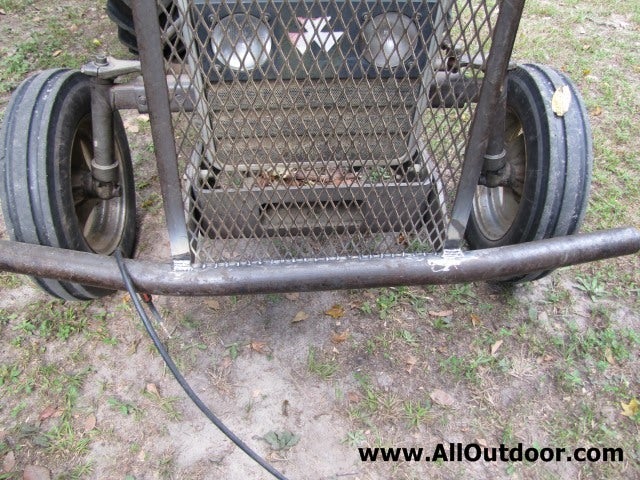Farm Welding Basics
Kevin Felts 10.11.16

While bush hogging through some heavy brush, the front of the tractor ran into a limb and broke a weld on the radiator guard. The brush guard frame is inch and a quarter angle iron with perforated steel making the actual guard. This is probably the second or third time the weld has broken. The weld itself is fine. The issue is the leverage put on the weld with the brush guard.
My welding qualifications:
- 2 years experience structural steel welder.
- 12 years experience fabrication AMSE certified pressure vessels and shell and tube heat exchanges. I have been certified on carbon steel, chrome and stainless. I have experience fitting and working with Monel, Hastelloy, Inconel, and a few other alloys. The vessels and heat exchangers I built had everything from water to hydrogen to phosgene running through them, but not all at the same time.
MIG, Stick or Fluxcore
Everything we are discussing is either 7018 welding rods or ER-70 welding wire. 6010, 6011 and 5P is fine for tacking, but not for welding.
Stick welding – Even though I have extensive experience with stick welding and have been certified, I do not have a stick welder at home, nor do I plan on getting one. Leave the stick welding to the pipeliners, construction workers, and fabrication shops. The flux on the outside of the rod helps protect the weld puddle from hydrogen and oxygen, which can cause pinholes.
Pinholes are small, round holes in the finished weld.
For welding around the farm, stick welding usually burns too hot. When welding sheet metal or thin metal with welding rods, the base metal will melt away, which leaves a hole. Then there is storing the welding rods and the cost of the rods.
If I was welding in a production shop and was working on at least 1/4 inch thick steel, then I would go with stick rods. The rods are expensive and are more difficult for new welders to learn than either MIG or fluxcore.
MIG – Stands for Metal Inert Gas. I have heard it called Metallic Inert Gas, and that is what I often refer to it as. The standard gas mixture for MIG welding is 75/25 (75% argon and 25% carbon dioxide). There are other mixtures, but they are used for specialized welding. The inert gas provides a shield to protect the molten metal from hydrogen and oxygen.
If the gas shielding is blown by a gust of wind, the weld can develop pinholes.
While moving a MIG machine, you have to take the bottle of compressed gas into consideration. There is the wire feeder, bottle, and power supply, which is a welding machine.
MIG welding is best suited for inside a shop or shed where the job can be brought to you and where the wind can be blocked. With MIG welding keep in mind, wind = pinholes.
Fluxcore – Is a mixture of stick welding and MIG welding. Fluxcore, just as it’s name implies, has flux in the middle of the wire, thus no need for a gas shield. I have seen fluxcore welding use a gas shield. Usually this is in heavy welding applications or in windy situations where extra shielding is desired.
For welding around the farm I use a generator and a fluxcore welding machine. This setup is highly portable and there is no worry of compressed gas bottles. Fluxcore or the most part eliminates the need for mixed gas bottles.
MIG vs Fluxcore -Torn between buying a MIG or fluxcore machine? Ask yourself two simple questions.
Question 1: Is the majority of your welding outside or inside a building?
MIG = inside a building where the wind can be blocked. This is where the jobs are brought ot you.
Fluxcore = outside in the wide open. This is where you go to the jobs.
Question 2: Do you want to deal with bottles of compressed gas? Do you want to stop welding and go get a bottle refilled, especially on a weekend?
I opted for fluxcore.
MIG and fluxcore use the same strength welding wire, which is ER-70. One square inch of ER-70 is rated at 70,000 pounds, which is the same as a 7018 welding rod. Funny how that works out.
Weld contamination
Welding around the farm, the usual causes of weld contamination are rust, paint, and old welds. Welding over an old weld can draw out contaminates, such as pin holes. When possible, grind as much of the old weld off as is feasible. Get the old weld off and down to good base metal.
Use a wire buffing wheel or grinding disk to remove paint and/or rust.
After each pass of weld, use a buffing wheel or wire brush to remove welding flux.
That is pretty much it for now. In future articles we will be discussing safety and different types of welding in more detail